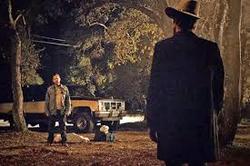Of course, real fencing was not nearly as swashbuckling as I’d hoped, but it was still pretty cool. I quickly learned that I didn’t care for foil, the standard Olympic weapon. Too many rules; really, in what world could you strike your opponent in the head and it not count?! Saber seemed very romantic and even swashbuckling, but again . . . rules. Right of Way. Corps a’ Corps. Such a nuisance.
But Epee. Ah, now here was the sweet science! Hit or be hit; Right of Way be damned . . . what “target area?” Ah, this was the life. I loved the Epee, and as the semester wound down, I moved naturally into the NAU Fencing Club. The NAU Fencing Club shared space and membership with guys from the local Society for Creative Anachronism (SCA), and they did “historical fencing,” which for them meant rapier and dagger. Still fewer rules, which meant I was interested. I’m not a “rules” kind of guy.
I fenced for years, mostly doing rapier and dagger, but as often happens, eventually life got in the way and I fell away from it. Then I moved and never really re-connected with it. I would window shop online for swords and read occasional articles about history or techniques, but there was no one to practice with. In the intervening years, “historical fencing” had given way fully to HEMA, or Historical European Martial Arts. HEMA is distinctly different from its predecessors because of its concentration on primary sources as well as its breadth of study. Members of the SCA may choose to study sources, and some are quite knowledgeable, but it’s not an expectation, and such organizations have an element of fantasy to them that HEMA does not. HEMA is the perfect martial art for someone who appreciates research and citation. It has become increasingly popular, but not so much so that there is a HEMA McDojo just down the street; actual places to train are not so very common.
But there is one in Phoenix, where I live now. The Phoenix Society of Historical Swordsmanship hosted a special seminar a couple of weekends ago which promised guests they would “Learn Everything.” The study of HEMA covers everything from the medieval period until deep into the 19th century, so to “learn everything” in a weekend is a pretty tall order, but the folks over at the Phoenix Society did a bang up job of providing a solid overview of everything you could know and study, and they showcased some of their top-notch instructors as well. Several of those who ran seminars are nationally or internationally ranked competitors in their chosen weapons (did I mention that HEMA is popular?), and Richard Marsden, one of the co-founders of the Phoenix Society, literally wrote the book on Polish Saber.
Over two days of instruction on Polish saber, 19th century pugilism, sword and buckler (it looks so much easier than it is!), singlestick, and a broad introduction to a major medieval master named Fiore, whose work covered everything from hand-to-hand, single sword and longsword. I also got a refresher on rapier and smallsword (I never fenced smallsword, but it shares a common framework with Olympic foil). We also had instruction on some of the intangibles of the fencing arts, covering timing, tempo, and distance. The most fun, however, was cutting practice, when students were able to practice real cuts on rolled Tatami mats (the traditional cutting medium of Japanese sword practitioners) with live steel, and students were even allowed to bring sharps in and try a cut with their own blades!
So if you find yourself in the Phoenix area, check out the Phoenix Society of Historical Swordsmanship.
https://www.phoenixswordclub.com/
If you’re not in the Phoenix area, but find a kindred spirit in d’Artagnon, Robin Hood (or Little John), Sir Walter Raleigh, or King Arthur, you can find a HEMA affiliate here:
https://www.hemaalliance.com/club-finders/
Richard Marsden's book on the Polish Saber:
www.amazon.com/Polish-Saber-Richard-Marsden/dp/0984771654/ref=sr_1_1?ie=UTF8&qid=1496644495&sr=8-1&keywords=polish+saber



 RSS Feed
RSS Feed
